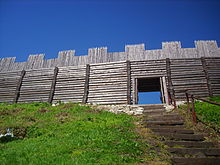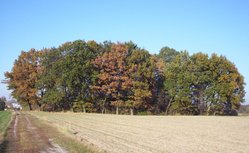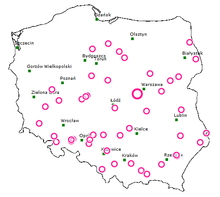- Gord (archaeology)
-
 Reconstructed West Slavic fortified settlement (gord) in Groß Raden, Germany
Reconstructed West Slavic fortified settlement (gord) in Groß Raden, Germany Part of reconstructed fortifications on the mount of Birów near Ogrodzieniec, Poland
Part of reconstructed fortifications on the mount of Birów near Ogrodzieniec, Poland
Gord is a medieval Slavic fortified settlement. This Proto-Slavic word (*gordъ) for town or city, later differentiated into grad (Cyrillic: град), gard,[1][2] gorod (Cyrillic: город), etc.[3][4][5] The ancient peoples were known for building wooden fortified settlements. The reconstructed Centum-satem isogloss word for such a settlement is g'herdh , gordъ, related to the Germanic *gard and *gart (as in Stuttgart, Białogard, Stargard etc.).
Similar strongholds were built during the late Bronze and early Iron Ages by the people of the Lusatian culture (ca. 1300 BC – 500 BC), and later in the 7th - 8th centuries CE in modern-day Russia, Belarus, Ukraine, Poland, Slovakia, Czech Republic and eastern Germany. These settlements were usually founded on strategic sites such as hills, riverbanks, lake islands or peninsulas.
A typical gord was a group of wooden houses, built either in rows or in circles, surrounded by one or more rings of walls made of earth and wood, a palisade and/or moats. Some gords were ring-shaped, with a round, oval or occasionally polygonal fence or wall surrounding a hollow. Others, built on a natural hill or a man-made mound, were cone-shaped. Those with a natural defense on one side, such as a river or lake, were usually horseshoe-shaped.
Most gords were built in densely-populated areas, and situated in places which presented particular natural advantages. However, as Slavic tribes united into states, gords were also built for defense purposes in less populated border areas.
Those gords which served as a ruler's residence or lay on trade routes, quickly expanded. A suburbium (Polish: podgrodzie) formed near or below the gord. Its population served the residents of the gord and could shelter within the gord's walls in the event of danger. Eventually the suburbium would have its own fence or wall. In the High Middle Ages, the gord would normally evolve into a castle or citadel (kremlin); the suburbium – into a town.
Some other gords, which did not stand the test of time and were abandoned or destroyed, gradually turned into more or less discernible mounds or rings of earth (known in Russian as gorodische, in Polish as grodzisko, in Ukrainian as horodyshche, in Slovak as hradisko and in Czech as hradiště). Notable archeological sites include Biskupin, Poland and Bilsk, Ukraine (see Gelonus).
Evolution of the word
The Proto-Slavic word *gordъ means a "fenced area", compare to Ukrainian horodyty, Czech ohradit, Russian ogradit, Croatian/Serbian ograditi and Polish ogradzać meaning "fence away". It ultimately finds its root in the Proto-Indo-European language; cognates are many English words related to enclosure: "yard", "girdle," and "court." In some modern Slavic languages, *gordъ has evolved into words for a "garden" (likewise a fenced area, from which Latin hortus, and English horticulture and orchard): the Ukrainian ґород (gorod) and город (horod), the Bulgarian and Macedonian градина (gradina), the Polish ogród, the Slovak záhrada, the Czech zahrada, the Russian огород (ogorod). In some Slavic languages, *gord has evolved into a word for "town" or "city": the Russian gorod, the ancient Pomeranian and modern Kaszubian gard, the Bulgarian, Croatian, Macedonian and Serbian град, grad. The Slovak and Czech hrad and Slovene grad have evolved to mean "fortified castle." The Polish gród and Ukrainian horod retain their original[citation needed] meaning of an "ancient fortified settlement."
Polish word podgrodzie meant settlement near a town (Slavic prefix pod- means "under" or "below", equivalet of Latin sub-) because in fact gród was built at hill's top frequently. It survived to these days in names of several villages (i.e. Podgrodzie, Subcarpathian Voivodeship) and town's districts (i.e. district of Olsztyn).
The names of many Central and Eastern European cities hark back to their past as gords. Some of them are in countries which used to be, but no longer are, inhabited mostly by Slavic-speaking peoples. Examples include: Novgorod, Gorodets, Volgograd (Russia); Hrodna, Davyd-Haradok, Haradok, Navahrudak (Belarus); Uzhhorod, Horodok, Horodysche (Ukraine); Hradec Králové, Vyšehrad (Czech Republic); Stargard Szczeciński, Starogard Gdański, Nowogard, Ogrodzieniec, Grodzisk Mazowiecki (Poland); Dravograd, Gornji Grad (Slovenia); Biograd, Stari Grad (Croatia); Visegrád (Hungary); Belgrade (Beograd), Dimitrovgrad, Veliko Gradište (Serbia); Danilovgrad (Montenegro); Blagoevgrad, Asenovgrad, Razgrad (Bulgaria); Gradsko (Republic of Macedonia); Novohrad region, many places named Hradisko (Slovakia) or Hradište (Czech Republic);[6] Graz (Austria); Gartz, Stuttgart (Germany); Pogradec (Albania), Višegrad (Bosnia and Herzegovina).
In old Iran (Persia) Gerd had the same meaning. This word changed to Jerd after Arab invasion. Burugerd or Borujerd is a city in West of Iran.
See also
- Gordoservon in Asia Minor, 680 AD
- Garðaríki - Varangian name for Kievan Rus, interpreted as "cities"
- Biskupin, a life-size reconstruction of a gord-like Lusatian settlement in Poland.
- Fortified settlements in other cultures:
- Kraal (South Africa);
- Motte-and-bailey (western Europe).
- Burgh, Borough, Burg or bjerg (Scotland, England, Germany, Denmark)
- Isengard Fictional town of an antagonist group in J. R. R. Tolkien's Lord of the rings. Name derived from Isen=Iron.
References
- ^ ON. garðr; goth. gards; den. -gaard; island. -gard; cimb. -garthur; aleman. -gardo; welsh. -gardd; holln. -gaerde; span. -gardin; pomern. -gard; slav. -grod, -hrad
- ^ A Concise Etymological Dictionary of the English Language. Oxford. 1911; Jane Chance. Tolkien and the invention of myth. . 70
- ^ Taylor, Isaac (1898). Names and Their Histories: A Handbook of Historical Geography and Topographical Nomenclature. Original from the University of Michigan: Rivingtons. p. 331. http://books.google.com/books?id=faxMAAAAMAAJ&dq=wall+Grad+gorod&cad=0.
- ^ Taylor, Isaac (1864). Words and Places, Or, Etymological Illustrations of History, Ethnology, and Geography. Original from Oxford University: Macmillan. p. 128. http://books.google.com/books?id=fxQLAAAAQAAJ&dq=wall+Grad+gorod&cad=0.
- ^ Anthropologische Gesellschaft in Wien (1880). Mittheilungen der anthropologischen Gesellschaft in Wien. Original from the University of Michigan: F. Berger & Söhne. p. 40. http://books.google.com/books?id=HqcbAAAAMAAJ&pg=PA40&dq=Gord+wall+Grad+gorod.
- ^ en.wikipedia.org/wiki/Uherské_Hradiště
External links
- Reconstruction of a gród at Grzybowo, Poland – images of a typical ancient Slavic settlement with suburbium, earth-and-wood wall and moat; by Tomek Birezowski (Polish text).
Categories:- Fortification
- Slavic culture
- Archaeology of Poland
- Human habitats
Wikimedia Foundation. 2010.




